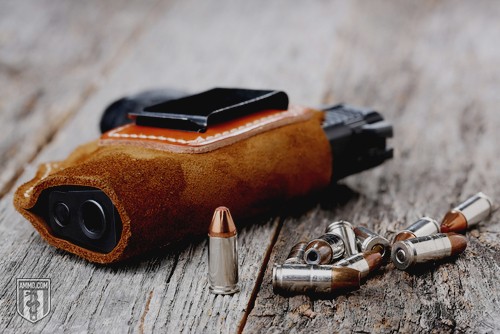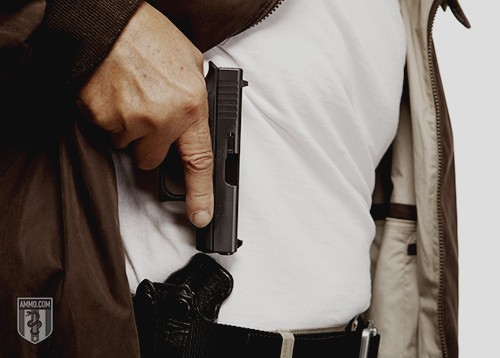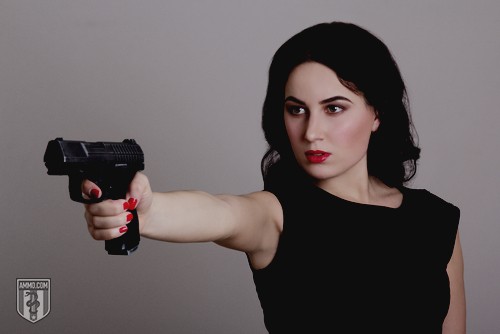Holsters for Self Defense: A Guide to Carrying Concealed
You're free to republish or share any of our articles (either in part or in full), which are licensed under a Creative Commons Attribution 4.0 International License. Our only requirement is that you give Ammo.com appropriate credit by linking to the original article. Spread the word; knowledge is power!
 You’ve made the decision to carry a firearm. Maybe you’ve already picked out your gun, and maybe you’ve already shot it. Now, it’s time to wear it. But it can be confusing knowing where to start.
You’ve made the decision to carry a firearm. Maybe you’ve already picked out your gun, and maybe you’ve already shot it. Now, it’s time to wear it. But it can be confusing knowing where to start.
After all, there are holsters that clip on the outside of your pants, ones that fit on the inside of your ankle, and even ones that go in your pocket. How are you supposed to know which one is right for you and your gun?
This guide will walk you through the benefits of wearing a holster and how to choose which ones will best fit your lifestyle and weapon.
What’s Your Carry Purpose?
People carry guns for different reasons, and the holster you choose depends on your purpose for having the gun in the first place. That means while the man living on a 5,000-acre ranch may not care about concealing his 9mm when he rides to check the fence, the woman who lives in Detroit and walks home from work in the dark does care about concealment.
Keep this in mind as you talk about concealed carry with your friends and family. When you’re looking for a holster to be used for self defense, it’s going to be different than the ones people wear at the range or shooting club. It’s going to be different than what police and security guards use, and it very well may be different than what your next door neighbor wears. And that’s okay – as long as it works for you and your gun.
Characteristics of Good Self-Defense Holsters
When carrying your self-defense firearm, there are a few things that all good holsters have in common. Regardless of whether you’re carrying a Beretta Pico at your hip or a 9mm Glock under your arm, these are the traits you want to look for in a self-defense holster:
- It fits snug against your body. Not only will an ill-fitting holster be uncomfortable, but it can draw attention if it’s bouncing around, which is not what you want.
- It holds the firearm tight. If your gun isn’t tight in its holster, it becomes a risk during a physical altercation. If you’re fighting someone, thrown to the floor, or even running away, you need to be sure your firearm is going to stay put.
- It’s able to be carried concealed. If you want to use a gun for self defense, it’s always best to wear it concealed. You don’t want to draw unwanted trouble or make people feel uncomfortable because they can see your weapon.
- It has a smooth presentation. A good holster allows you to easily draw your gun out of the holster and return it without issue. If you have to fumble with the straps or it takes two hands to remove it, it’s no good for self defense (where every second counts). The quicker you can get it out and ready to aim, the better.
- It protects your gun. Your holster should offer a level of protection from both the outside elements and your body. Rain and sweat can do damage to a firearm, but with the right holster, both can easily be avoided.
Comfort and Function
Along these same lines, a holster needs to be comfortable and functionable. If it’s not, there’s no way you’re going to wear it on a regular basis. Here are some of the things to keep in mind as you determine what kind of holster you should choose.
- Using a holster that’s on your body is always better than one off the body. That means an in-the-waistband holster should be chosen over a concealed-carry purse, and a hip holster over a specialized concealed-carry jacket. When your firearm is on your body, it’s safer, easier to reach, and has less chance of falling into the wrong hands.
- For most people, a holster at the waist or hip tends to be the most efficient. It’s always within reach of your dominate hand and makes it more difficult for someone to remove it from your person.
- Don’t just buy a holster, try it on. Wear it around the store. Do some jumping jacks. Bend down like you’re grabbing something off the bottom shelf at the grocery store. Do what you do every day and see how it feels. Does it stay in place? Does it jab you in the ribs? Does the holster print on your back every time you bend over? These are things you can only know by trying one on and moving around.
- One may not be enough. This is especially true for those who wear a variety of clothing. There are men who need something that can be worn with a business suit, a pair of jeans, and clothes from the gym, and women who need a holster for dresses, work clothes, and going out with friends. That’s okay – you don’t wear the same pair of shoes for every occasion, and you don’t need to wear the same holster either.
- One made specifically for your gun is best. While there’s thousands of universal holsters out there, the fact remains that the best-fitting holster is one that is made for your specific make and model of gun. It’s going to firmly hold it, keep it snug, and fit like a glove.
Retention
Another important aspect to consider when choosing what kind of holster to carry your self-defense weapon in is retention. Handgun retention refers to how well the holster holds on to the firearm. Different holsters retain weapons in a variety of ways.
- Friction: A rather effective form of retention, friction keeps a gun held snugly in place and is often how leather holsters work. It’s especially effective when the holster is molded to fit a specific gun. As it conforms to the weapon, it touches more of the surface area and holds it in place better.
- Tension Screw: Often used by Kydex holsters, tension screws can be tightened or loosened to get the right amount of friction on your handgun. While this is effective, some screws have a tendency to work their way loose in as little as a day.
- Thumb Break: Typically seen by those who open carry, the thumb break is a lever that straps across the back of the gun, holding it in place. While it does require an extra step during draw, it stops others from getting your firearm away from you.
- SERPA Lock: Used by law enforcement officers, these holsters offer what is referred to as Level 3 active retention. SERPA holsters use a mechanical rotating hood to keep the gun in the holster and some offer a locked trigger guard for extra protection. SERPA holsters use a button release to allow for a quicker draw.
- ALS Lock: Automatic Locking System (ALS) holsters are self-locking for your safety. Once in place, an ALS holster locks the firearm in place in all directions, where it stays until the thumb lever is activated.
Holster Options for Self-Defense
 With the basics of what makes a good holster understood, you’re closer to knowing what kind of holster is best for you and your handgun.
With the basics of what makes a good holster understood, you’re closer to knowing what kind of holster is best for you and your handgun.
Material
Most holsters are made of either leather, nylon, or Kydex (a hard polymer plastic). Each of these has its own pros and cons.
Leather: Leather holsters often have a lower profile and conceal better than their counterparts. While they are often more expensive and need to be broken in, those made from quality leather last longer and don’t lose their integrity as they age.
Nylon: Affordable and often found in universal shapes and sizes, nylon holsters are weather resistant, fast drying, and easy to clean. On the other hand, they typically require both hands to re-holster, soak up oil, stretch, and wear out as they age.
Kydex: A hard, stable plastic, Kydex is durable and strong. Most Kydex holsters use tension screws for retention, so once you have the right fit, your handgun should slide in and out effortlessly. Although strong, these holsters may rub some guns the wrong way and cause wearing on the steel. And because of their durable construction, they tend to be bulkier than leather holsters and do not conform to your body.
Belt Holster
It’s no wonder that the belt holster is one of the most popular ways to carry a firearm. Easy to use and comfortable to wear, these holsters are mounted on a belt with either loops or slots. Some use a paddle to make removal easier.
For self defense, these holsters are worn on the dominant hip and are easy for the wearer to locate and draw from. They also require the use of a strong belt. Without one, the hip holster can make your pants sag, making you constantly pull them up.
Yet they do have their drawbacks. Worn on the outside of the pants, these holsters are harder to conceal, especially in form-fitting clothing. They’re also more likely to expose your weapon during a struggle. Also keep in mind that those holsters equipped with paddles sometimes tilt the butt of the firearm inward, pushing the barrel out. This can create a bump in the contour, again making it more identifiable.
Inside the Waistband
Another popular carry option, inside-the-waistband holsters give you better concealment and easy access. Because these holsters are worn low and kept close to the body, retention is less of a problem.
When trying different holsters, be sure that the gun’s grip is high enough that you can wrap your whole hand around it, securing it during your draw. If using a nylon or leather in-the-waistband holster, look for one that’s reinforced so it stays open after the draw.
Most inside-the-waistband holsters use clips to hold the holster in place. Others use a non-slip, rubber-like coating that grips onto the fabric of your pants to hold it in place. This style can often slip and after some time, the coating does wear off.
Shoulder Holster
Moving away from the hip, shoulder holsters are another great option for concealed carry and self defense. Most can be worn with the handgun on either side, although under the non-dominant arm is preferred. This allows for quick and easy access to the gun. It also makes carrying and concealing a large handgun easier.
Designed to be customizable, shoulder holsters typically have multiple points of adjustment to ensure the best fit possible. For those who regularly wear jackets, blazers, and vests, shoulder holsters are a favorite – but they do take time to get accustomed to.
Some can seem quite complicated the first few times you wear them. By taking the time to get the proper fit, the holster’s comfortability increases dramatically. It should also be mentioned that extra care be taken during the draw from a shoulder holster. Due to its design, there is a point that the firearm can be pointed at one’s own body. So be sure not to shoot yourself.
Pocket Holster
While it may seem easy and safe to stick a handgun in your pocket, it’s not. And that’s why there are pocket holsters. These holsters are designed to keep both you and your gun safe and accessible. And with a trigger cover to prevent accidental firing and a reduced silhouette of the gun in your pocket, it’s easy to understand why they’re popular.
Pocket holsters keep the barrel of your gun clean and free from dust and debris, as well as ensure it stays oriented in your pocket. That way when you reach in to draw it out, you’re coming in contact with the gun’s grip, not its barrel. These holsters also allow you to access your weapon without anyone knowing.
The downsides of a pocket holster are that it can only be used with small guns and it’s pretty much impossible to draw when you’re sitting.
Other Types of Holsters
The range of holsters doesn’t end here. There’s belly bands and bra holsters, as well as others made to wear on the thigh and ankle. But these holsters are not realistically designed for self defense. The draw isn’t quick enough and they’re not accessible.
Yet, in some circumstances, they may be your only option. If need be, consider using any of the following holsters:
- Belly band
- Bra shelf
- Thigh holster
- Ankle holster
- Concealed-carry purse
Best Holster Brands
When it comes to what holster is best for you, there is no right answer. It depends on what gun you’re carrying, where you’re carrying it, what you’re wearing, and how comfortable you are with it.
That being said, some holsters are way better than others. A quality holster always performs better, as does one that’s made specifically for your make and model of firearm.
Here are some of the best brands of holsters for self defense.
- Galco
- Safariland
- Wright Leather Works
- Raven Concealment
- Alien Gear
- Stealth Operator
- Tucker Gun Leather
- Kramer Handgun Leather
- Remora Holsters
- DeSantis Holsters
Holster Considerations for Women
 While all the above information is relevant to both men and women, there are special considerations for women who are carrying a firearm. There are multiple reasons for this: the shape of the body, a shorter waist-to-hip ratio, and the silhouette of women’s clothing. Yet that doesn’t mean women can’t carry concealed or for self defense.
While all the above information is relevant to both men and women, there are special considerations for women who are carrying a firearm. There are multiple reasons for this: the shape of the body, a shorter waist-to-hip ratio, and the silhouette of women’s clothing. Yet that doesn’t mean women can’t carry concealed or for self defense.
They can. And do.
With a few hints and tips, it’s not hard for women to carry concealed. Just keep these things in mind:
- Move away from wearing tight shirts. Instead, opt for loose, flowing shirts and wear them untucked.
- Wear patterns and florals over solid colors. These hide bulges easier and are less likely to have noticeable gun prints.
- Wear low-rise pants. This increases the draw space and gives you smoother presentation.
- When purchasing pants, go up half a size. That way you have more room for in-the-waistband holsters without compromising your comfort.
- Choose pants and skirts that have sturdy belt loops and avoid elastic waistbands. This type of clothings isn’t designed to hold up a handgun and won’t do a very good job of it.
- Consider wearing sleeveless vests. It’s an easy fashion accessory that helps you hide your weapon and can make you feel more comfortable with concealed carry.
- If you’re wearing skirts or dresses, find ones with pockets. You can slit the inside of the pocket to give you easy access to a thigh holster.
- If necessary, consider your options. Bra holsters allow for form-fitting clothing, while a thigh holster hides the gun’s silhouette from view. These may not be your first choice, but it gives you an option other than no gun at all.
Working Around Holster Issues
For some people, finding the right holster can seem impossible. Whether it’s from age or a disability, there are some things that can make wearing a holster seem like an uncomfortable chore.
Here are a few ways to handle certain holster issues to make concealed carry more efficient and functionable.
Limited Motion
If you suffer from limited motion from a disability, injury, or age, opt for a snap or clip-on holster worn on the dominant hip. This way, you don’t have to rotate or reach behind you to draw the weapon. If a snap is used, be sure that you can open it with one hand, as they’re sometimes difficult to maneuver.
Also try to avoid shoulder holsters. They’re difficult to get into and the extra weight may make mobility issues more difficult.
Chronic Pain
If you suffer from chronic pain, be sure to keep both your firearm and its holster lightweight.
Wear it low and snug on the hip so you don’t have to reach or twist to draw it. It may be beneficial to move the spot where it touches your skin regularly, so it doesn’t become overly sensitive.
Back Pain
If you suffer from back pain, you want something that’s easy to use and doesn’t add too much bulk or weight. Keep the firearm near the front of the body to avoid twisting, and consider a belly band. These holsters wrap around the midsection and can also act as a support and brace for a bad back.
Small Children
If you have small children, carrying a weapon can feel overwhelming, but it doesn’t have to be. With a little preparation and planning, it’s easy for parents to carry concealed and protect both themselves and their children.
Here are a few tips and tricks.
- Wear your firearm securely on the body and limit its exposure.
- Carry your child on your non-dominant side.
- Learn to wear your child, that way you keep both hands free and ensure your child is out of the way.
- Always choose a holster with a trigger cover, keeping it safe from little wandering hands.
General Self-Defense Tips
 Carrying a handgun can protect you in self-defense situations, but it’s not the only thing that can. That’s why it’s vitally important to understand basic self-defense strategies and utilize them well before you ever have to pull your weapon.
Carrying a handgun can protect you in self-defense situations, but it’s not the only thing that can. That’s why it’s vitally important to understand basic self-defense strategies and utilize them well before you ever have to pull your weapon.
- Avoid being a target. Stay out of dangerous neighborhoods and don’t flash your wallet.
- Be aware of your surroundings. Turn your music off. Put your phone down. Have your keys in your hand and walk to your car with a mission.
- If you can get away, do so. Even if it means running. Getting away from a bad guy is always better than engaging with him.
- Get loud. Yell. Scream. Don’t be shy. Draw as much attention as you can.
- Be on the defense. It’s always better to not get shot than it is to shoot the bad guy.
- Keep out of arm’s reach. If a criminal approaches and asks for your purse, throw it to him. Do whatever you can to not let him get his hands on you.
- If you need to, fight. Hit. Kick. Scratch. Play dirty. Fight like you’re fighting for your life. You probably are.
Remember, if you’re going to carry a firearm for self defense, choosing the right holster is almost as important as choosing the right gun. It needs to fit snug, hold your gun tight, and give a quick, smooth draw. If it does those things and feels comfortable, you’re well on your way to finding the best holster for you and your gun.
Self Defense
- Arming Yourself: A Woman's Guide to Self Defense and Concealed Carry (CCW)
- Protecting Your Family: A Parent's Guide to Self Defense and Concealed Carry (CCW)
- Arming the Elderly: A Self-Defense Guide for Senior Citizens
- Holsters for Self Defense: A Guide to Carrying Concealed
- Arming Toddlers and The "Kinder-Guardians" Program: A Shamefully Bad Idea
- Handgun Wounding Factors: A Caliber Effectiveness Guide for Self Defense and Body Damage
- Self Defense for LGBT: Self-Protection and Concealed Carry (CCW) for the LGBT Community
- Arming the Disabled: A Self-Defense and Concealed Carry Guide for People With Disabilities
